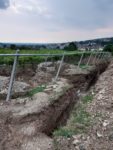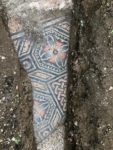 An elaborate ancient Roman mosaic floor dating to around the 3rd century A.D. has been discovered under a vineyard in the town of Negrar di Valpolicella near Verona. The trenches dug so far reveal long uninterrupted stretches of mosaic pavements with polychrome patterns of geometric shapes, guilloche, wave bands, floral vaults and the semi-circular pelta.
An elaborate ancient Roman mosaic floor dating to around the 3rd century A.D. has been discovered under a vineyard in the town of Negrar di Valpolicella near Verona. The trenches dug so far reveal long uninterrupted stretches of mosaic pavements with polychrome patterns of geometric shapes, guilloche, wave bands, floral vaults and the semi-circular pelta.
The presence of a Roman villa at the Benedetti La Villa winery, still in operation today, was known since the 19th century. Indeed, the name of the winery is taken from the name of the contrada (meaning neighborhood or district), evidence of culturally transmitted knowledge of a grand villa there. The first remains were discovered during agricultural work in 1887.  They were fragments of geometric mosaics, damaged in the course of the work, but the landowner dug down some more and discovered important figural mosaics depicting scenes of gladiatorial combat, two panels of Cupid driving a two-horse chariot and a religious ceremony. The panels were removed and the remains covered back up. Eventually the owner sold them to the city of Verona and they are now in the Archaeological Museum at the Roman Theater in Verona.
They were fragments of geometric mosaics, damaged in the course of the work, but the landowner dug down some more and discovered important figural mosaics depicting scenes of gladiatorial combat, two panels of Cupid driving a two-horse chariot and a religious ceremony. The panels were removed and the remains covered back up. Eventually the owner sold them to the city of Verona and they are now in the Archaeological Museum at the Roman Theater in Verona.
Even in 1922, when the first official archaeological dig took place there, there was no complete mapping and documentation performed. That dig unearthed three rooms paved with beautiful mosaic floors. There are dig journals, photographs and sketches, but at no point did the then-Archaeological Superintendency of Venice actually mark a map with a black x to record where they’d found what.
 Numerous attempts were made in subsequent decades to find the villa and another smaller mosaic was discovered in 1975 and covered back up with soil for its preservation. Last summer, archaeologists returned to the site, digging long, skinny exploratory trenches among the terraced vines with the goal of systematically locating the full villa. They used the notes from the 1922 and 1975 digs, lacunose though they be, to ascertain the likeliest spots. At first they found walls, a stone slab pavement and steps believed to be part of the service area of the villa, so not a place where expensive mosaic flooring would be.
Numerous attempts were made in subsequent decades to find the villa and another smaller mosaic was discovered in 1975 and covered back up with soil for its preservation. Last summer, archaeologists returned to the site, digging long, skinny exploratory trenches among the terraced vines with the goal of systematically locating the full villa. They used the notes from the 1922 and 1975 digs, lacunose though they be, to ascertain the likeliest spots. At first they found walls, a stone slab pavement and steps believed to be part of the service area of the villa, so not a place where expensive mosaic flooring would be.
In August they unearthed the northernmost edge of the 1922 excavation and the first mosaic emerged. They had to stop there due to budgetary limitations and because it is a working vineyard, after all, and late summer/early fall is their busy season. Excavations resumed in October after the vintage and again in February only to be shut down by coronavirus quarantine. A week after excavations finally picked up again,  archaeologists have hit paydirt.
archaeologists have hit paydirt.
Surveyors will liaise with the owners of the vineyard and the municipality “to identify the most appropriate ways to make this archaeological treasure hidden under our feet available and accessible”.
Technicians will need “significant resources” to finish the job. But local authorities have pledged to give “all necessary help” to continue with the excavation.